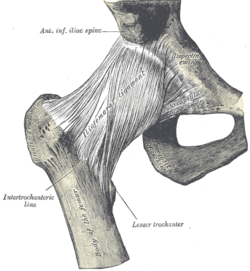Intertrochanteric line
| Intertrochanteric line | |
|---|---|
 Right hip-joint from the front. (Intertrochanteric line labeled at bottom left.) | |
 Right femur. Anterior surface. (Intertrochanteric line visible near top, as diagonal line below neck.) | |
| Details | |
| Latin | linea intertrochanterica |
| Identifiers | |
| Gray's | p.245 |
| Dorlands /Elsevier | l_10/12496187 |
| TA | A02.5.04.009 |
| FMA | 74587 |
| Anatomical terms of bone | |
The intertrochanteric line (or spiral line of the femur[1] ) is a line located on the anterior side of the proximal end of the femur.
Structure
The rough, variable ridge stretches between the lesser trochanter and the greater trochanter forming the base of the neck of the femur, roughly following the direction of the shaft of the femur. The iliofemoral ligament — the largest ligament of the human body — attaches above the line which also strengthen the capsule of the hip joint.[1] The lower half, less prominent than the upper half, gives origin to the upper part of the Vastus medialis.
Just like the intertrochanteric crest on the posterior side of the femoral head, the intertrochanteric line mark the transition between the femural neck and shaft.[2]
The distal capsular attachment on the femur follows the shape of the irregular rim between the head and the neck. As a consequence, the capsule of the hip joint attaches in the region of the intertrochanteric line on the anterior side, but a finger away from the intertrochanteric crest on the posterior side of the head.[3]
The fibers of the ischiocapsular ligament attaches both on the joint capsule and to the intertrochanteric line.
Clinical significance
Intertrochantric fractures
This area of the femur being the important pillar for weight bearing of the body is subject to lot of dynamic stress, pathological strain, physiological strain and trauma. This area gets injured and fractured due to high velocity trauma in young and trivial trauma in the old. The fractures in this line are called intertrochantric fractures and are classified as per the pattern of the fracture geometry. This bone unites as this is a spongy bone but is notoriously known for its union in unacceptable positions. It needs surgical fixation invariably for early mobilization and return to independent life style.
References
This article incorporates text in the public domain from the 20th edition of Gray's Anatomy (1918)
Bibliography
- Platzer, Werner (2004). Color Atlas of Human Anatomy, Vol 1: Locomotor system (5th ed.). Thieme. ISBN 3-13-533305-1. (ISBN for the Americas 1-58890-159-9.)
- Timothy D., White; Pieter A. Folkens (2005). The Human Bone Manual. Academic Press. ISBN 0-12-088467-4. Retrieved 2008-10-11.
External links
- Anatomy figure: 17:01-07 at Human Anatomy Online, SUNY Downstate Medical Center
- lljoints at The Anatomy Lesson by Wesley Norman (Georgetown University) (hipjointanterior)
| ||||||||||||||||||||||||||||||||||||||||||||||||||||||||||||||||||||||